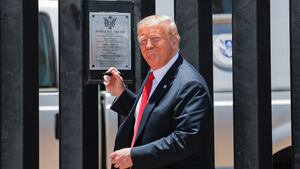Former President Donald Trump’s lawyers and New York state investigators duked it out in court Friday morning, as both sides sought to score a decisive victory ahead of a trial that threatens to topple his real estate empire and drain his bank accounts.
“There was rampant fraud in preparation of Trump’s personal financial statements,” said Andrew Amer, a lawyer at the New York Attorney General’s Office. “The defendants used those fraudulent statements repeatedly and persistently with banks and insurance companies in transactions seeking financial benefits.”
Amer argued that Trump has “ultimate responsibility” over the way he faked personal financial statements to inflate the value of his properties to augment his net worth by $2.2 billion or more. The former president’s own records for the backbone of the $250 million lawsuit the AG’s office last year against Trump, his top lieutenants, and the heirs he appointed as Trump Organization executives.
“To the extent they try to blame others or downplay their roles… that does not shield them from liability,” Amer said, noting that the evidence shows that the former president can’t possibly claim that he isn’t directly responsible.
In one example, Amer noted how Trump repeatedly valued his South Florida oceanside estate of Mar-a-Lago at 28 times more than the official Palm Beach County government property appraiser. A chart displayed in the courtroom showed how the former president’s winter home was valued by the county in 2018 at $25 million—while the real estate mogul set the value at $714 million.
In another example, the AG’s office pointed out how the Trumps’ simply slapped on a 30% “brand premium” at Trump National Golf Club in Jupiter, Florida. They also raised the theoretical purchase price of that business enterprise by tacking on $41 million in club memberships—even though those signups are reimbursable and under certain circumstances would have to be paid back.
“He can’t have it both ways,” Amer said, noting that Trump added value on one side of the balance sheet while declaring that liability at zero dollars.
The evidence on display was extensive. Investigators found that Trump duped insurance companies by lying about his stash of cash. They claimed that the Trumps inflated the value of Trump Tower in Midtown Manhattan by an estimated $178 million by incorrectly declaring funds as “stabilized income” when it wasn’t. And in one of the most brazen examples, investigators pointed out that when the Trumps were supposed to list deals with outside companies, they actually included management contracts between Trump Organization business entities.
“Money that was just flowing from one pocket to the other,” Amer said.
To knock down any notion that these real estate deals are too old to sue over—a major sticking point in this case—state investigators explained how Trump kept benefitting handsomely from lies years after he made them. In his presentation to the judge, Amer noted that the Trumps closed on a deal to acquire the Doral Resort & Spa in Miami’s suburbs in 2012, but then faked financial statements filed with the bank every year after that all the way up to 2021.
Letting this go would be tantamount to “a license to commit fraud on any existing loan” years later on mandatory financial disclosures, Amer said.
At the end of their presentation, the AG’s lawyers asked the judge to decisively declare that fraud has already been proven—paving the way to make the upcoming trial merely an assessment of how much money the Trumps should pay up as punishment.
Former Florida solicitor general Christopher Kise on Trump’s legal team began his presentation at 11:30 a.m., accusing the AG’s investigators of taking an “ignore everything” approach that doesn’t account for the idea that banks didn’t really rely on Trump’s personal financial statements. Besides, he said, these loans worked out in the end.
“These are all successful, profitable business transactions,” Kise said. “The attorney general is supplanting the sophisticated judgment of banks and insurers for her own opinions.”
The Trump family’s legal team questioned the AG’s authority to pursue this lawsuit and argued that it seeks to clamp down on real estate deals that are too old to even consider in court.
Kise told the judge that eight of 10 real estate deals are simply too old for the court to review, because the loans and contracts were completed before a July 2014 cutoff date recently issued by a state appellate court this summer. He went on to accuse the AG of shifting its case around in a legal brief filed just two weeks ago by trying to now focus on Trump’s subsequent financial statements, which did happen within the allowable time period.
“The Attorney General cannot now advance a new theory,” he said.
Under Trump’s defense theory, state investigators would have to drop any case against loans related to his Seven Springs forested estate north of New York City, the Trump Park Avenue building in Midtown Manhattan, the golf club in Doral, the Trump International Hotel and Tower Chicago, as well his contracts to operate a golf course in the Bronx and lease a historic building in Washington that until recently made it a Trump-branded hotel.
“You have to look at what the wrong is. The wrong is that you obtained a loan. If you look at the construct [of the AG’s lawsuit], it’s centered around the obtaining of the loan that you otherwise would not have been able to obtain. You can’t pivot on that theory,” Kise said.
Notably, Engoron pushed back on that idea, acknowledging that the AG’s lawsuit says “obtaining loans.” But he refused to read that so narrowly, given that Trump was only able to keep these loans alive by submitting the paperwork he’s accused of fabricating.
“I’m not going to exclude maintaining loans,” Engoron said.
The AG is hoping that Justice Arthur F. Engoron, who is already intimately familiar with the long-running investigation and case, will decide that Trump’s lies are entirely proven—and side squarely with law enforcement before the trial even starts.
Meanwhile, Trump’s team wants to convince Engoron that there’s no real case here.
However, Engoron in past court hearings has repeatedly shown absolute astonishment at the extent of Trump’s lies, often noting the way Trump on paper tripled the size of his Manhattan penthouse at Trump Tower, simply making up the existence of 20,000 square feet that inflated the value of his property by more than $200 million in that instance alone.
At Friday’s hearing, state attorneys presented testimony from the Trump Organization’s disgraced chief financial officer, convicted tax cheat Allen Weisselberg, who admitted that the penthouse size listed on official business documents was totally fake. The judge raised the possibility that this total fabrication was an “honest mistake,” but then quoted Justice Oliver Wendell Holmes, who served on the Supreme Court in the early 1900s.
“Even a dog knows the difference between being kicked and being tripped over. There’s a difference between lies and misstatements,” Engoron said.
One particular exchange perfectly captured how Trump’s distorted sense of reality conflicts with reasonable math. At one point shortly before a lunch break, the judge’s law clerk, Allison Greenfield, probed one curious detail that came up in the real estate mogul’s testimony at a deposition earlier this year. In it, Trump tried to justify his vastly inflated real estate values by reasoning that the prices eventually went up—thereby, somehow making his past assessments accurate.
Greenfield asked Kise to explain the former president’s stance that “if properties go up in value… that would retroactively justify a value it had in the past. The future will go back and justify the past? I wonder if you can address that.”
Kise took rejected the idea, offering a confusing explanation that seemed to defy the most fundamental cosmological concept that time only moves forward.
“The present demonstrates that his valuations at the time were correct,” he said. “He gets to provide his view of the world, and the banks totally and completely understand that.”
“President Trump is a master at finding value where others see nothing. He’s made billions in real estate investments,” he said.
By mid-afternoon, the judge finally lost his patience with Kise's dismissive relativism, particularly after the lawyer said that "these vast disparities are normal in this process… that's the nature of this business. This is how money is made and lost, and this is why people like Donald Trump have been successful.”
The judge gently banged on his desk as he said, exasperated: "You cannot make false statements and use them in business. That's what this statute prohibits, and that's the allegation!"
This is the last big fight expected before a trial that’s set to start on Oct. 2.
In the background, though, a cloud temporarily hangs over the case. Both sides are simultaneously engaging in a fight in the state’s appellate courts over the scheduled start of the trial. Last week, Trump’s team took the unusual step of suing the judge directly, an attempt to force him to make key decisions about the statute of limitations—a bid that could delay the trial if the First Department appeals court takes longer than a few days.
But the move was widely seen as premature—and stupid. Engoron is expected to soon issue a ruling on Friday’s arguments, one that would render the appellate fight moot.
The AG’s attempt to hold Trump accountable for decade-old deals has long been a point of contention in the case. In his deposition this past May, Trump seemed particularly incensed about how far back the AG was reaching in her lawsuit, snapping at Kevin Wallace, an investigator who was questioning him.
“I don't know how you go back to 2011, because I always thought that there was a Statute of Limitations. I'm the only one that doesn't get a Statute of Limitations. So you'll have to explain that at some point,” Trump said. “Well, I think it's very unfair.”








